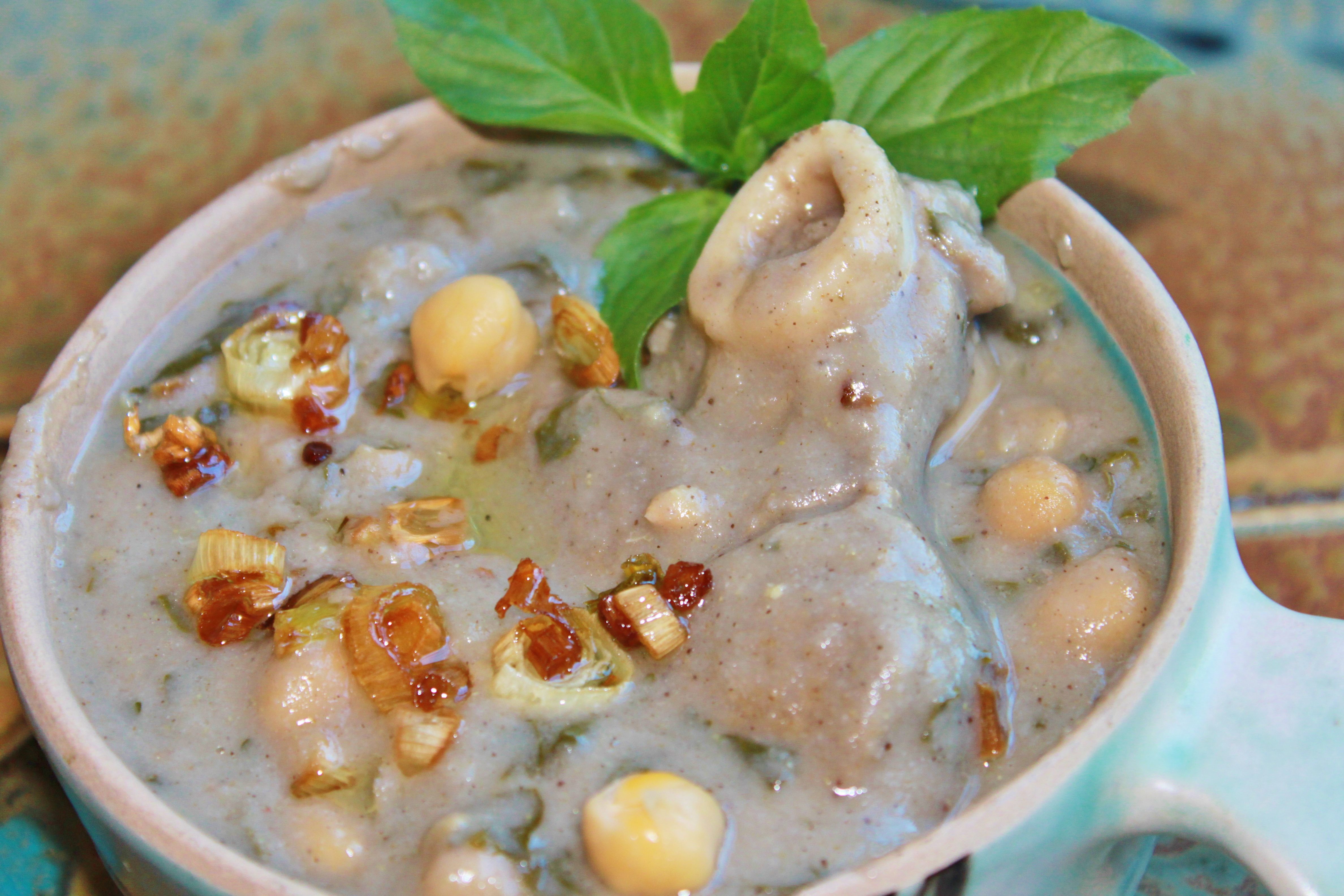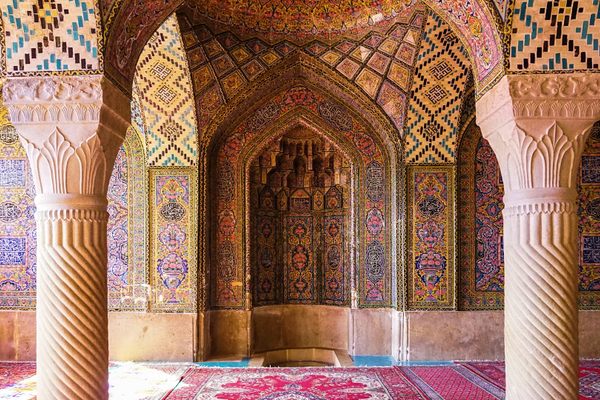The 10th-Century Baghdad Cookbook That’s a Poetic Tome to Food
The text features exhaustive directions for cooking, eating, and being.

During the Medieval Islamic era, civil and religious leaders in Baghdad—known as caliphs—hosted legendary, opulent banquets within their courts. Communal dishes lined tables and drinks flowed freely. The caliphs peppered in entertainment throughout the meal as well, often asking revelers to sing praises about the food before them. One such caliph, al-Mustakfī, implored people to gather one day to recite poetry and dish about food. That day, people waxed about the likes of kamakh, an ancient countertop cheese. Later, at al-Mustakfī’s behest, they made the food that they’d praised in song and verse.
Food and drink was a common cause for celebration in the Medieval Islamic world—a far cry from how, say, Medieval Europe conceived of food. “They liked to talk about food, they enjoyed it, and they had no prohibitions whatsoever,” says Nawal Nasrallah, an Iraqi scholar, author, and translator. “It’s unlike, for example, in Europe during Medieval times, where talking about food was considered a kind of gluttony. In Islam it was permissible.”
In the 10th century, intellectuals and creatives of the Muslim world flocked to Iraq. Baghdad, the capital of the Abbasid dynasty, grew substantially during this “golden era.” Caravans often passed through the city, which contributed to it becoming a place of both cultural and culinary exchange. “At this time it attracted all the world’s riches, material, spiritual, and intellectual alike,” writes Lilia Zaouali in the preface to her book Medieval Cuisine of the Islam World. “Cultures and languages from the world over came together here, coexisting and, of necessity, blending with one another.” Scholars, poets, philosophers, historians, and caliphs thrived in Baghdad.
The vast expansion carved out spaces for “prosperous leisurely classes that demanded the best wealth could offer, which naturally included gourmet cuisine,” as Nasrallah writes in her translation of the 10th-century Baghdadi cookbook, Annals of the Caliphs’ Kitchens. Nothing illustrated one’s taste and class like knowing how to cook, and from there, writing cookbooks and manuals became popular. That’s part of why the Middle East came to have the most in-depth trove of medieval food literature in the world. As Charles Perry notes in his foreword to Medieval Cuisine of the Islam World, “there are more cookbooks in Arabic from before 1400 than in the rest of the world’s languages put together.”
Annals of the Caliphs’ Kitchens, written around the 10th century by Ibn Sayyar al-Warrāq, is the earliest-known of these cookbooks. It’s an exhaustive tome that immortalizes Baghdad as a thriving cultural and culinary epicenter, with 615 recipes culled from more than 20 cookbooks and dozens of poems praising culinary wonders. It took centuries to come out of obscurity, however.

Nasrallah immigrated to the United States in the 1990s from Iraq. “People asked me about my food; I think this is a way of trying to know people better,” Nasrallah says. “So I tried to refer to cookbooks.” Finding nothing, she then set out to write her own Iraqi cookbook. While researching what would become that book, Delights from the Garden of Eden, she uncovered something unusual at IU’s library: two cookbooks from medieval-era Baghdad, written in the 10th and 13th centuries, respectively. While the earlier book had been edited in the 1980s, it hadn’t been translated. Stunned by this discovery, Nasrallah decided to take it on. She translated the book into English, which was published in 2007.
Alternately known as Winning a Lover’s Heart and Sparing Him the Need for a Doctor, the book meticulously documents every detail important to making delectable meals for friends and distinguished guests. It’s remarkable in how it also doubles as a how-to guide for everything from remedies for burnt foods to the humoral properties of cold foods. There’s a chapter devoted to “manners observed when commoners share meals with their superiors and kings,” musings on proper etiquette, and a list of “soups for cold-related maladies.”
This focus initially struck Nasrallah. “What surprised me is that I opened the book and about the first 20 chapters or so, there were no recipes,” she says. “The guy was just talking about the properties of food, the nature of food, the strength of meat.” As Perry notes, caliphs often employed Christian physicians who knew the Greek school of medicine, which is why the idea of serving vegetable dishes to the sick is a central part of the book. (Yet vegetable dishes in this book are known as muzawwar, meaning “counterfeit.”)

These chapters point to the all-encompassing way that people thought about food, and explains why the manuscript stayed shelved for so many years, Nasrallah notes. “I don’t think they looked past the first five or six chapters before deciding what this book was,” she says. “So they categorized it as a book of medicine, when, in fact, it’s a proper cookbook.”
Annals of the Caliphs’ Kitchens also doubles as a love letter to food and drink, featuring poems from then-famous wordsmiths alongside recipes. For instance, a recipe for white zirbaja (a delicate bird stew) is accompanied by an al-Hafiz-penned poem about it:
Zirbaja is a unique dish, which of all the living creatures only the smartest relish.
Languishing in yellow, like flowers and sprouting grass in spring,
Having had its fill of saffron crushed. Free of flaws and blemish.
It comes in a bowl of silver shining white, as if from the light of the moon stealing …
Not much is known about the scribe who put this book together, though Nasrallah notes in her introduction that the author’s nickname, “al-Warrāq,” likely points to the fact that he was in Baghdad’s book industry. (At the time, writers and scribes flocked to markets known as “sūq al-warrāqīn,” where they could conduct research on pre-existing texts and earn commissions by compiling books). In the text, he writes that he was commissioned, almost certainly by a wealthy someone, to put together a cookbook that documented the foods that princes, caliphs, elites, and others dined on. Perry speculates that his patron may have been Saif al-Daula, a Hamdanid prince looking to implement culinary arts to bolster both his cultural cache and his Aleppo court. The fact that al-Warrāq included 10 poems by Kushajim, a member of al-Daula’s circle, and noted that he learned them first-hand, lends further credibility to this theory.
Regardless, it’s clear that whoever commissioned al-Warrāq to write the book wasn’t just interested in step-by-step instructions on how to make, say, raisin wine. They were invested in understanding the minutiae of how a meal is constructed, which flavors go well together, and the effects that certain foods might have on someone’s mood and stomach. The cookbook especially stressed anthologizing Abbasid cuisine, with “an eye on demystifying it to facilitate its duplication in relatively simpler kitchens,” as Nasrallah writes.
It’s clear that people were concerned with cultural preservation. “These cookbooks reflect the salient aspects of the societies of their time, inasmuch as they respect the conventions of their predecessors and perpetuate the models of the Abbasid tradition that their authors knew from their own reading,” writes Zaouali. “There was no break with the old traditions, then, but rather an accumulation of knowledge and an enrichment of the culinary art that went hand in hand with the broader aim of cultural enrichment under Muslim rule.”

The recipes from Annals of the Caliphs’ Kitchen hold up, too. Nasrallah guest lectured about the book and demonstrated some of the recipes at Boston University’s History of Food gastronomy course. There, she used recipes from the book to make the likes of bazmaward, a pinwheel sandwich crafted from eggs, nuts, vegetables, and cheese, and shredded chicken dipped in a pomegranate-walnut sauce, known sibagh. The cold dishes, especially ones containing eggplant, are a standout, she says.
While some of the procedures may be different, they’re not that distant from Iraqi cuisine today. “I was surprised by the similarities between what we cook now and what they cooked,” Nasrallah says. “We’ve been cooking all these dishes, and there were people a thousand years ago … who were cooking the same thing.”
Gastro Obscura covers the world’s most wondrous food and drink.
Sign up for our regular newsletter.





































Follow us on Twitter to get the latest on the world's hidden wonders.
Like us on Facebook to get the latest on the world's hidden wonders.
Follow us on Twitter Like us on Facebook